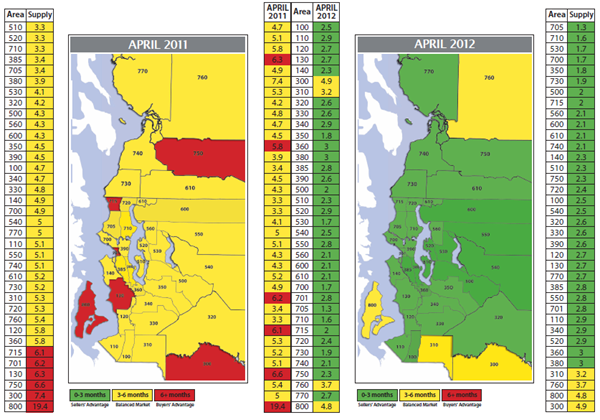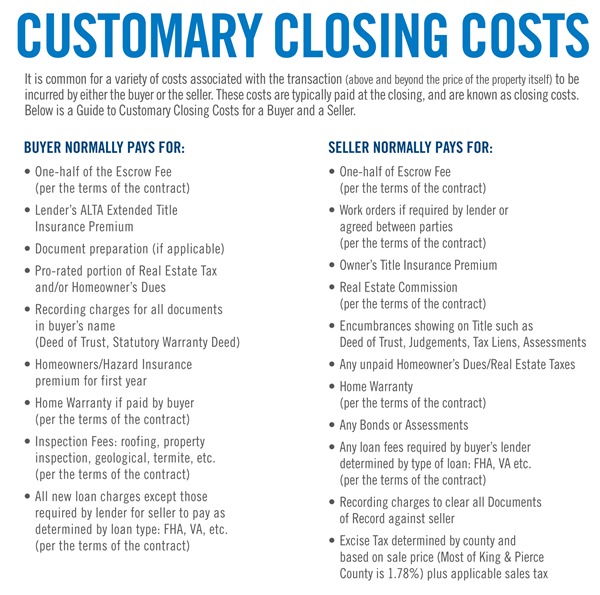Archives for May 2012
It’s Getting Hot Out There: April Inventory
 Though green may not be an intuitive color to express the current temperature of the market, in this graph it expresses areas with less than 3 months of inventory. Most observers would consider this a market favoring sellers and quick moves by the buyers.
Though green may not be an intuitive color to express the current temperature of the market, in this graph it expresses areas with less than 3 months of inventory. Most observers would consider this a market favoring sellers and quick moves by the buyers.
Let me know how I can help. Here is a copy of this chart. MonthsofInventory_April
FHA Weighs Rule Reversal, Boon for Condo Sales?
 The Federal Housing Administration is reportedly considering revising rules that many in the real estate industry have called overly strict and that have left many condo units ineligible for FHA’s low-downpayment mortgages.
The Federal Housing Administration is reportedly considering revising rules that many in the real estate industry have called overly strict and that have left many condo units ineligible for FHA’s low-downpayment mortgages.
For example, one sticking point under the FHA’s rules has been that “individual condo units cannot be sold to buyers using FHA-insured mortgages unless the property as a whole has been approved for financing,” The Wall Street Journal reports. However, condo association boards are increasingly opting not to obtain recertification of their buildings for FHA loans due to its tightened regulations against condo units.
FHA’s regulations “have had an enormous impact on individuals,” says Moe Veissi, president of the National Association of REALTORS®. More condo unit residents are finding they are unable to sell their unit because the condo board hasn’t obtained approval from FHA, Veissi told The Wall Street Journal. This then can have a roll-over affect that negatively impacts the price of condo units in the buildings then.
Half of all condo buyers tend to use FHA mortgages, and it’s an important source of lending for first-time and minority home buyers, Christopher L. Gardner, managing member of FHA Pros, a consulting firm that helps condo boards obtain FHA approvals, told The Wall Street Journal.
FHA officials say they are willing to reconsider some of their rules that have raised such an outcry among condo owners, lenders, and real estate professionals. For example, one rule the FHA is reportedly reconsidering is its stance on non-owner occupancy. As of now, FHA requires that no more than 50 percent of the units in a condo building be non-owner occupies. “This rule alone has made large numbers of condominiums in hard-hit markets ineligible for FHA financing, where investors have purchased units for cash to turn into rentals,” The Wall Street Journal reports.
FHA also is reportedly revisiting its condo rules on how many owners in a building can be delinquent on their fees. As of now, FHA refuses to approve a project if more than 15 percent of the condo units are 30 days or more late on their condo association fees, The Wall Street Journal reports.
Source: “Condo Sales May Become Easier if FHA Revises Rules Governing Mortgages,” The Wall Street Journal (May 18, 2012)
Where Are House Prices Actually Headed?
We are often asked where we believe home values are headed. To answer this question we want to quote three separate reports that have been published in the last 60 days: the Home Price Expectations Survey (HPES), the Urban Land Institute Real Estate Consensus Forecast (ULI) and the Demand Institute’s Report (DIR): The Shifting Nature of U.S. Housing Demand. Here are their projections:

by THE KCM CREW
Millennials Want to Be Home Owners, Too
 The conventional wisdom today around the millennial generation, often defined as having been born between 1980 and 2000, seems to be that they aren’t as interested in owning a home as previous generations. Recent stories in the media go so far as to claim that the dynamic, diverse people in this group prefer the flexibility of renting to the stable, long-term arrangement provided by home ownership.
The conventional wisdom today around the millennial generation, often defined as having been born between 1980 and 2000, seems to be that they aren’t as interested in owning a home as previous generations. Recent stories in the media go so far as to claim that the dynamic, diverse people in this group prefer the flexibility of renting to the stable, long-term arrangement provided by home ownership.
However, this is a misinterpretation of present-day trends, said Dr. Glenn Crellin, a professor at the Runstad Center for Real Estate Studies, University of Washington. He was part of a panel of experts at a session on real estate demographics Friday morning at the National Association of REALTORS®’ Midyear Legislative Meetings & Trade Expo in Washington, D.C.
Crellin acknowledged that the home ownership rate among the under-35 population in 2011 was just under 40 percent (compared to the national rate of approximately 65 percent), and that home ownership levels had declined more sharply among those under 35 than among other groups since the housing bubble burst. But he said many in the media were drawing the wrong conclusions from that data.
"Recently, headlines showed the general press believed we were entering an era of rentership," Crellin said. "[As a result], they believe home ownership doesn’t deserve the kind of support it had been given."
But Crellin pointed out that the rate of home ownership for those under 25 today is actually higher than that of the under-25 baby boomers in 1970. Also, a recent poll of Washington State University students that he conducted showed that 48 percent of them expect to buy a home in the next 3-5 years.
While the willingness of young people to purchase a home is certainly there, the financial means to do so may not be, Crellin said. The underlying story, then, is not one of shifting mindsets but rather changing economic factors. "[The recession] is probably going to delay purchases, but it’s not the permanent transition that the national press is predicting," he explained.
The millennials, also known as echo boomers and generation Y, present a long-term opportunity for the housing market but are having a very difficult time in today’s economic climate, said Selma Hepp, an NAR research economist. They have a higher unemployment rate than that of other generations, and the ones who do have jobs are often plagued by little to no income growth and heavy consumer and student-loan debt.
Hepp outlined high-, medium-, and low-performing scenarios for housing between now and the end of the decade. In the low-performing scenario, which assumes continued economic struggles and difficulties in obtaining financing, people who were between 15 and 34 years old in 2010 will form 15.6 million new households by 2020. In the high-performing scenario, people from that same group would form 18.8 million new households by 2020 — approximately 10 million of which would be new home owners. In the medium-performing scenario, which falls between the previous two on the spectrum, 17.1 million new households would come into being.
Even if the high-performing scenario comes to fruition, the kind of housing available today presents a challenge. Hepp pointed out that the senior population, including many baby boomers would release more housing that it would absorb over the next two decades. But a great deal of these homes — suburban properties built when energy costs were much lower and traditional, "nuclear" families were much more common — aren’t in high demand among millennials and gen Xers.
Members of these generations are interested in more urban communities that have cultural and commercial amenities close by, ideally within walking distance. Consequently, it’s not surprising that demand for owned-attached houses, such as condos and townhomes, are expected to grow 15 to 20 percent between now and 2030. That will make it the fastest-growing residential category in terms of demand by far, said Professor G. Stacy Sirmans of Florida State University.
— Brian Summerfield, REALTOR® Magazine




